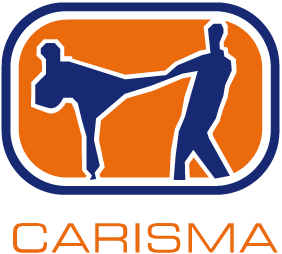Information for beginners
Behaviour during classes
Learning
Warming up
Breathing
Practicing
Information for beginners
Whether you are a beginner interested in joining our club or you just started to train at CARISMA you should read carefully these lines. During the first few lessons the movements practiced and even the stances learnt might seem awkward. On top of that most people have a feeling of general of body stiffness after the first few lessons. This is absolutely normal and should not be considered as a deterrent to continue training. The warming up can be very demanding for a person not trained to do press ups, sit ups and the other exercises we usually practice.
Behaviour during classes
Each lesson has a beginning and an end, officially stated by the master (or the instructor running the class). Each person entering the class after its beginning or having to leave the class before the end should notify the master and wait for his approval. During classes students should:
- listen very carefully to each instruction received by the master or by the instructors
- maintain a behaviour that is quiet, and respectful toward the master, the instructors and the
other members of the club - notify immediately the master or an instructor about any accident happened during a class
- never sit down or rest, unless autorised by the master
Learning
The process of learning a new technique means understanding from which position the movement should start, which parts of the body should be moved and in what position the movement should finish. When learning a technique the most important aspect is the co-ordination of movement and the correct shift of weight and/or changing of position. Other factors like focus (e.g. being able to hit something as, when and where desired), power and speed will come as result of the overall training.
Warming up
At the beginning of every training session, before starting to practice any technique we always warm up. Our warming up includes various different sets of exercises and it usually runs for about 30-35 minutes. The purpose of warming up is to put the body in the best state to handle the rest of the training. The exercises done during warming up improve both power (the source of speed) and flexibility (in order to reduce resistance against movements). Many people, particularly beginners, need to pay serious attention to their legs’ flexibility in order to be capable of kicking at a certain height. Those who find this difficult are suggested to practice some of the stretching exercises on their own in order to get flexible more quickly and catch up with the rest of the class. The abdominal area is a very important part of the body. It’s the only protection for delicate organs like stomach and liver: there are no bones here like in the chest. Strengthening the abdominal area is also very important in order to kick high, hard and fast. Our warming up activity pays a great deal of attention to the abdominals.
Breathing
Breathing is essential for life. Breathing correctly is essential for a good practice of martial arts and physical activities in general. When making a physical effort it’s essential to time the breathing to the rhythm of the exercise. The correct way for it is breathing in before an exercise and breathing out during completion. We teach to finish every punching and kicking technique while exhaling.
Breathing should be done with nose at all times. Breathing with the mouth comes in most cases more natural but is less healthy then breathing with nose. On top of that while practicing techniques and sparring is very dangerous to keep the mouth not perfectly shut. In case of a punch or a kick hitting the head while the mouth is open can cause teeth to chip, tongue damages or the jaw can easily dislocate with painful consequences. It’s very important to remember that while performing hard physical work (e.g. sparring) the body requires extra oxygen intake. While sparring is essential not showing the fact that you are running out of breath because a skilled fighter may at that point take advantage of it by increasing the rhythm and hitting the chest area.
Practicing
Each student decides how often, how hard and what activities he/she wants
to train. The training session intensity varies from time to time according to the average skills and experience of the various people present at that particular session. Sessions can include basics (e.g. single techniques, kicks or punches on the spot or moving), extra curricula techniques (elbows and knees), combinations (e.g. multiple attacks combining any sequence of techniques, eventually followed by partner’ counter attack) or self-defence techniques adapted to real life situations. During training in pairs, students have to try first to achieve a good technical level in the technique execution. Once this first goal is achieved then other aspects of the exercise, such as speed, co-ordination and power should be pursued. This way of training will quickly bring unexpected results in terms of overall performance. The training partner should always pay a lot of attention to the way the his/her partner executes the various techniques. Any minor mistake should be quickly notified in order to adjust the execution on the fly. Major mistakes should be notified at the end of the series of exercises to avoid disturbing other students’ training. In these cases the instructor should be informed.

